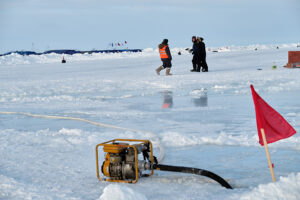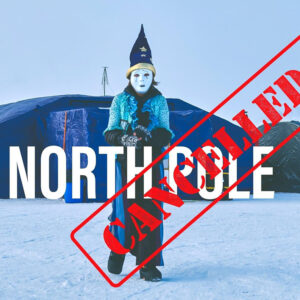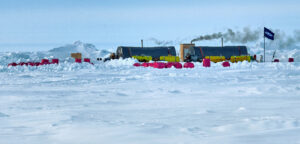Nowadays, hikers build cairns as an “I was here” statement, but in polar exploration, that was only one of its roles. Cairns also alerted other explorers that a particular party had passed that way. Usually, the explorer who built a cairn left a note saying where he was going.
It was traditional for whoever later found the note to collect it but make a copy of the message and replace it in the cairn, along with a message of his own.
If undisturbed, a cairn will remain in place for 1,000 years. In the Arctic, where few travel on foot, many of the explorers’ original cairns are still there. If you do your homework, you can usually determine who built a particular cairn, and when.
Nothing connects you to arctic history like coming upon one of these relics of the past and knowing the circumstances around it. I’ve played this Find the Cairn game for years.

Twenty members of George Nares’s crew labored to build the massive Alert cairn at Floeberg Beach, Ellesmere Island in 1875-6. Photo: Jerry Kobalenko

The hyper-competitive Robert Peary built his Roosevelt cairn one mile further north than Nares’s, on the same beach, and topped it with a cross of iron-shoed sled runners. Photo: Jerry Kobalenko

In 1925, Godfred Hansen reused a Nares cairn on northern Ellesmere Island to mark a supply depot for a planned Roald Amundsen expedition that never took place. Hansen’s rust-colored Royal Danish tin, with stenciled lettering saying “Kjobenhavn”, indicates who left it. Photo: Jerry Kobalenko

Originally built by Robert Peary during his 1906 trek along the north coast of Ellesmere, this low cairn on a gravel spit on the NW corner of Ellesmere Island was visited by German explorer Hans Krueger in 1930. Krueger left three “all’s well” notes, including one here, then disappeared. Photo: Jerry Kobalenko

Robert Peary’s wind-blasted 1906 cairn atop Cape Thomas Hubbard at the northern tip of Axel Heiberg Island, overlooking the partly open Arctic Ocean. Photo: Jerry Kobalenko

Another Nares cairn, this one on the Cary Islands, off the coast of Greenland, near what is now Thule Air Base. In 1891, Swedish explorer Alfred Bjorling left a note here, then disappeared. Photo: Jerry Kobalenko

Built by Sir John Franklin during the winter of 1845-6 atop Beechey Island, just off southwestern Devon Island. Three of Franklin’s men died that first winter and are buried (and famously well-preserved) on the gravel beach below. The following summer, they sailed west in search of the Northwest Passage and died to a man. Photo: Jerry Kobalenko

Adolphus Greely’s men built this cairn above Fort Conger, on northern Ellesmere Island, during their 1881-84 expedition. Greenland, just 30km away, peeks out in the upper left background. Nineteen of Greely’s 25 men later starved to death. Photo: Jerry Kobalenko

The fallen remains of George Nares’s 1875 Post Office cairn at Discovery Harbour on Ellesmere Island, made from a giant pile of empty food cans filled with sand. Photo: Jerry Kobalenko

On a hilltop on northern Ellesmere Island, two of Robert Peary’s Inuit helpers, above, built a cairn and left the bamboo wand one was carrying in it…

…Both the cairn and the bamboo are still there. Photo: Jerry Kobalenko

Trigonometric cairn for mapping, left by Otto Sverdrup’s expedition in 1899 at Fram Haven, Ellesmere Island. Cocked Hat Island, an explorer’s landmark, is visible in the background. Photo: Jerry Kobalenko

Some cairns have inexplicably vanished, including two cairns from Otto Sverdrup that declared sovereignty over the High Arctic for Norway. Above, the purported site of his slutvarden, or end cairn, 80˚55′, western Axel Heiberg Island. Photo: Jerry Kobalenko

Sverdrup’s Lands Lokk cairn on NW Ellesmere Island also included a sovereignty declaration but is likewise nowhere to be found. This, despite an open landscape where even a low pile of rocks is visible for several kilometres. The northern tip of Axel Heiberg Island, 35km away, beckons faintly in the background. Photo: Jerry Kobalenko






